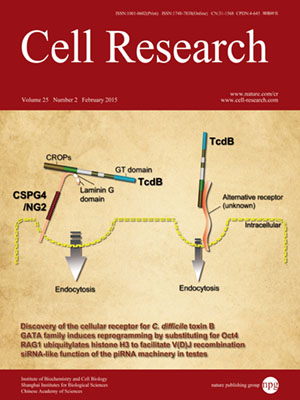
Volume 25, No 2, Feb 2015
ISSN: 1001-0602
EISSN: 1748-7838 2018
impact factor 17.848*
(Clarivate Analytics, 2019)
Volume 25 Issue 2, February 2015: 193-207 | Open Access
ORIGINAL ARTICLES
MIWI and piRNA-mediated cleavage of messenger RNAs in mouse testes
Peng Zhang1,*, Jun-Yan Kang2,3,*, Lan-Tao Gou2,3,*, Jiajia Wang1, Yuanchao Xue5,6, Geir Skogerboe4, Peng Dai2,3, Da-Wei Huang1, Runsheng Chen4, Xiang-Dong Fu5,6, Mo-Fang Liu2,3 and Shunmin He1
1Key Laboratory of the Zoological Systematics and Evolution, Institute of Zoology, Chinese Academy of Sciences, Beijing 100101, China
2Center for RNA Research, State Key Laboratory of Molecular Biology, University of Chinese Academy of Sciences, Shanghai 200031, China
3Shanghai Key Laboratory of Molecular Andrology, Institute of Biochemistry and Cell Biology, Shanghai Institutes for Biological Sciences, Chinese Academy of Sciences, Shanghai 200031, China
4Laboratory of Bioinformatics and Noncoding RNA, Institute of Biophysics, Chinese Academy of Sciences, Beijing 100101, China
5State Key Laboratory of Virology, College of Life Sciences, Wuhan University, Wuhan, Hubei 430072, China
6Department of Cellular and Molecular Medicine, University of California, San Diego, La Jolla, CA 92093-0651, USA
Correspondence: Shunmin He, Tel: 86-10-6480 7279; Fax: 86-10-6480 7279 E-mail: heshunmin@gmail.com; Mo-Fang Liu, Tel: 86-21-5492 1146; Fax: 86-21-5492 1011 E-mail: mfliu@sibcb.ac.cn; Xiang-Dong Fu, Tel: 1-85-8534 4937; Fax: 1-85-8822 6920(xdfu@ucsd.edu)
The piRNA machinery is known for its role in mediating epigenetic silencing of transposons. Recent studies suggest that this function also involves piRNA-guided cleavage of transposon-derived transcripts. As many piRNAs also appear to have the capacity to target diverse mRNAs, this raises the intriguing possibility that piRNAs may act extensively as siRNAs to degrade specific mRNAs. To directly test this hypothesis, we compared mouse PIWI (MIWI)-associated piRNAs with experimentally identified cleaved mRNA fragments from mouse testes, and observed cleavage sites that predominantly occur at position 10 from the 5′ end of putative targeting piRNAs. We also noted strong biases for U and A residues at nucleotide positions 1 and 10, respectively, in both piRNAs and mRNA fragments, features that resemble the pattern of piRNA amplification by the 'ping-pong' cycle. Through mapping of MIWI-RNA interactions by CLIP-seq and gene expression profiling, we found that many potential piRNA-targeted mRNAs directly interact with MIWI and show elevated expression levels in the testes of Miwi catalytic mutant mice. Reporter-based assays further revealed the importance of base pairing between piRNAs and mRNA targets and the requirement for both the slicer activity and piRNA-loading ability of MIWI in piRNA-mediated target repression. Importantly, we demonstrated that proper turnover of certain key piRNA targets is essential for sperm formation. Together, these findings reveal the siRNA-like function of the piRNA machinery in mouse testes and its central requirement for male germ cell development and maturation.
10.1038/cr.2015.4
FULL TEXT | PDF
Browse 2570


